Kingston DataTraveler Ultimate 3.0 & OCZ Enyo, Quick Look at Two USB 3.0 SSDs
by Anand Lal Shimpi on September 14, 2010 11:08 AM ESTSince I reviewed my first SSD, three things have happened. 1) Controllers have improved significantly. My personal favorite, SandForce’s SF-1200, can outperform the original X25-M by more than 3x in random write speed. 2) Consumer capacities have tripled. While the majority of SSDs sold are still under 100GB in size, you can now get 240GB and even 480GB consumer drives. 3) Prices have dropped. The first SSD I reviewed was Intel’s 80GB X25-M and it carried a $595 MSRP. OCZ will sell you a 120GB Vertex 2 for about half that today.
As a result of prices dropping, SSDs are being used for more than just expensive boot/application drives. Personally, I use a couple of old SSDs connected to Apricorn SATA-to-USB adapters as Windows 7 and Mac OS X 10.6 install discs. Using an SSD instead of a DVD drive speeds up OS install time considerably. I can install Windows 7 from one of these SSDs to an SSD in just under 3 minutes (timed from the moment it starts installing to the first reboot).
OCZ was the first to produce an interesting SSD for external use. The Enyo was an Indilinx Barefoot based SSD, much like the original Vertex, but paired with a SATA to USB 3.0 bridge in a very sleek package:
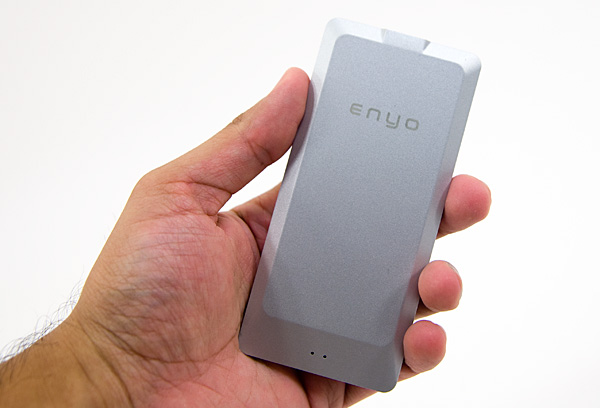
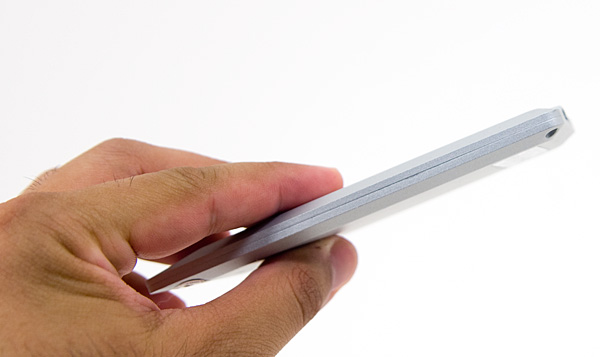
The aluminum housing is eerily reminiscent of Apple’s unibody MacBook Pro design, it feels very similar. Even the Enyo’s packaging is very Apple-like.
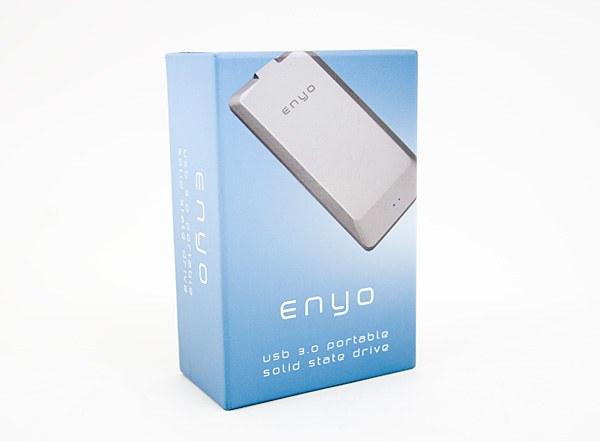
Since this is a USB 3.0 drive you have the requisite USB 3.0 cable. The micro-B connector on one end is unique to USB 3.0 devices (don’t lose the cable) while the other end will work in both USB 2.0 and 3.0 devices.
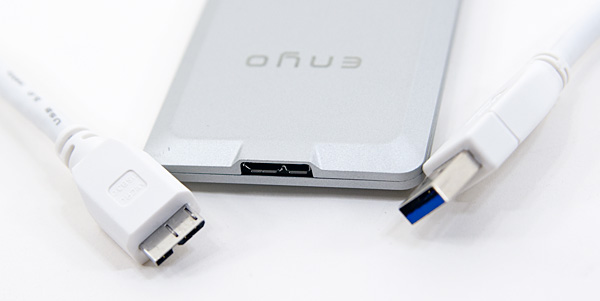
The resulting performance was pretty incredible for an external drive:
| OCZ Enyo Performance | ||||||
| Sequential Read (128KB) | Sequential Write (128KB) | Random Read (4KB) | Random Write (4KB) | |||
| OCZ Enyo 128GB USB 3.0 | 178.1 MB/s | 169.6 MB/s | 21.9 MB/s | 7.9 MB/s | ||
| OCZ Enyo 128GB USB 2.0 | 35.0 MB/s | 31.1 MB/s | 7.8 MB/s | 7.4 MB/s | ||
| Corsair Nova 128GB SATA | 222.1 MB/s | 184.0 MB/s | 37.5 MB/s | 14.4 MB/s | ||
It’s fast enough to pretty much do anything on, and close to the performance of an internal Indilinx based SSD. There’s no TRIM support, but you do get idle garbage collection assuming you have it plugged into your computer and have at least some free space on the partition. In my testing the garbage collection worked with NTFS partitions, I couldn’t get it working with HFS+ partitions.
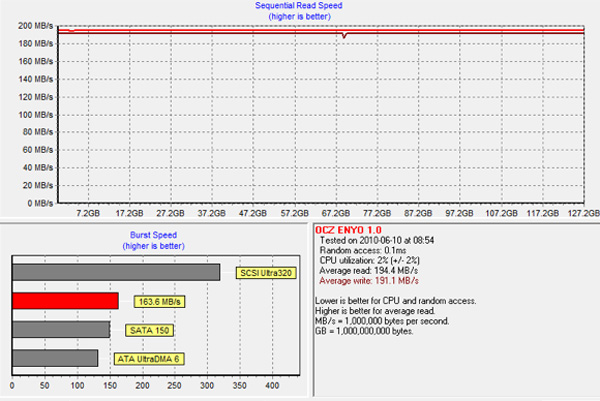
OCZ Enyo, clean performance
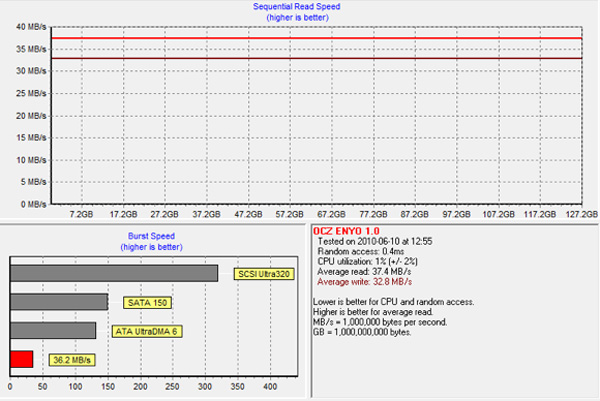
OCZ Enyo, after torture

OCZ Enyo, after drive has been idle for several hours

The Enyo continues to be unrivaled in the market, but its pricetag is tough to justify:
| OCZ Enyo Pricing | |||||
| 64GB | 128GB | 256GB | |||
| OCZ Enyo | $199 | $305 | $715 | ||
At $305 for a 120GB drive, you could actually buy a faster 120GB SandForce SSD and pair it with an external USB dongle. Of course it wouldn’t look as nice and it wouldn’t be as fast given that most SATA to USB dongles don’t support USB 3.0.
If you do have a use for it however, the Enyo gets the job done. I’d love to see OCZ cram a SandForce controller in there instead of the dated Indilinx controller though.
OCZ has traditionally gone after the high end of the SSD space, so the Enyo makes a lot of sense. But if you want something a bit cheaper to plug into your otherwise unused USB 3.0 ports, Kingston has another option.










18 Comments
View All Comments
Mithan - Tuesday, September 14, 2010 - link
I own 3 SSD's (2 in my desktop and 1 in a laptop) and plan on getting a 120-160gb for my Steam install drive at some point.I know most people here say "it isn't worth it for gaming" but I love the reduced load times.
Voo - Tuesday, September 14, 2010 - link
Well if you want to spend the money nobody can stop you, but since the most important thing for game loads ARE sequential reads, some modern 7.2k rpm drives in Raid0 would probably be not noticeably worse, while being cheaper and larger..Not that I don't love my 160gb Intel G2, but it's rather expensive for storage when comparing the alternatives.
taltamir - Tuesday, September 14, 2010 - link
I agree, SSD is the best gaming upgrade I had in years... it makes unplayable games playable (unplayable due to excessive load times ruining the mood and immersion... ex neverwinter nights 2)Fritzr - Tuesday, September 14, 2010 - link
I was checking prices and found 512GB SSDs. A bit pricey yet for use as a main drive at $1500+, but in 2.5" form factor it would make a nice replacement for my laptop's 120GB HDD :)Voo - Tuesday, September 14, 2010 - link
The new Intel toolbox manual has allegedly some screenshots of 600gb G3s in it. Seems believeable and could be interesting.vol7ron - Tuesday, September 14, 2010 - link
if only it would hit the $1/GiB, or lessRoland00 - Tuesday, September 14, 2010 - link
The kingston use the jmicron 612 controller or the jmicron 612b controller (the one with the reduced stuttering?)OneArmedScissorB - Tuesday, September 14, 2010 - link
The 601 and 602 controllers from about two years ago were the ones that had the stuttering issue, and even those were eventually fixed.The 612 is way beyond that era.
bji - Tuesday, September 14, 2010 - link
Citation please?It's my understanding that the 601 and 602 were *not* 'eventually fixed', there were some workarounds put into place that only very marginally helped the terrible, inexcusable random write performance. Everyone stopped using those chips because they were unfixable; if they could be fixed, we'd still see them in use.
You can say that the 612 is better, but I personally would never buy any SSD with a JMicron controller in it, 612 or otherwise.
Roland00 - Tuesday, September 14, 2010 - link
the JMF 602 had stuttering issues, the JMF 602b was a revision that majorly fixed the issue due to having twice the cache (the JMF 602b still occasionally had problems but less so).It is so hard to keep track of all these models...sigh...thanks for the correction.